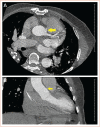Coronary Stent Placement in an Interarterial Anomalous Right Coronary Artery: An Alternative Approach in a Multimorbid High-risk Surgical Patient
- PMID: 36644625
- PMCID: PMC9820114
- DOI: 10.15420/icr.2021.24
Coronary Stent Placement in an Interarterial Anomalous Right Coronary Artery: An Alternative Approach in a Multimorbid High-risk Surgical Patient
Abstract
Anomalous aortic origin of a coronary artery is a rare congenital anomaly and potential aetiology for sudden cardiac death. However, the mere presence of this anomaly does not portend clinical significance, and there are many factors that contribute to limiting coronary blood flow in these patients. The standard of care for symptomatic individuals is surgical management with coronary unroofing although not all cases are amenable to surgery. We report the case of an anomalous right coronary artery with interarterial course managed by percutaneous coronary intervention due to surgical contraindication secondary to comorbidities. The proposed mechanism of action culminating in aborted sudden cardiac death is unique and involves aggravated pulmonary hypertension in an individual with severe comorbid pulmonary disease.
Keywords: Anomalous aortic origin; congenital heart defect; coronary angiography; coronary vessel anomaly; intravascular ultrasound; percutaneous coronary intervention; sudden cardiac death.
Copyright © 2022, Radcliffe Cardiology.
Conflict of interest statement
Disclosure: The authors have no conflicts of interest to declare. Informed Consent to Participate and Publish: All patients have given written informed consent.
References
-
- Warnes CA, Williams RG, Bashore TM et al. ACC/AHA 2008 guidelines for the management of adults with congenital heart disease: a report of the American College of Cardiology/American Heart Association Task Force on Practice Guidelines (Writing Committee to Develop Guidelines on the Management of Adults With Congenital Heart Disease). Developed in collaboration with the American Society of Echocardiography, Heart Rhythm Society, International Society for Adult Congenital Heart Disease, Society for Cardiovascular Angiography and Interventions, and Society of Thoracic Surgeons. J Am Coll Cardiol. 2008;52:e143–263. doi: 10.1016/j.jacc.2008.10.001. - DOI - PubMed
Publication types
LinkOut - more resources
Full Text Sources


